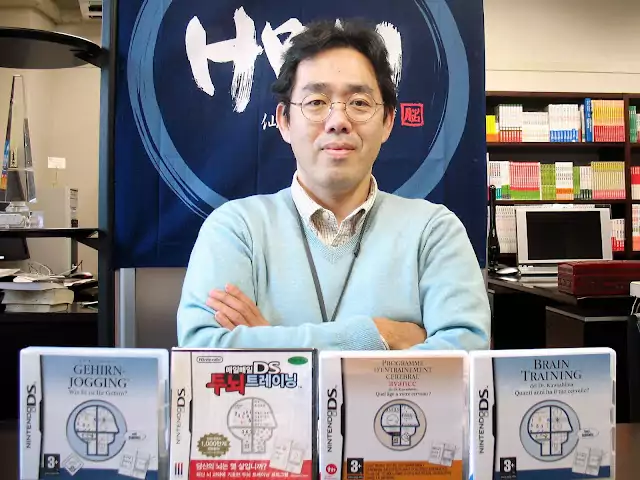Doctor Ryuta Kawashima, professor of neuroscience at Tohoku University, offers something that most people in the world believe they need – a better memory. His book Train Your Brain – 60 Days to a Better Brain, published initially in Japan in 2003 and then in an English version in 2005, is now available in a new Penguin format. Dr Kawashima specifies that his book is for adults with increasing forgetfulness, difficulty remembering people’s names, spelling words or expressing their thoughts. There are many books in print which try to assist with these problems by offering mnemonic devices, tricks, games and devices to jog the memory. Train Your Brain is not about memory aids, but goes to the heart of the problem, and stimulates the prefrontal cortex, thereby, Dr Kawashima claims, improving brain function and memory ability.
Theory behind the Brain Training Exercises
Dr Kawashima has spent twenty years researching the brain’s functions, using brain imaging devices to establish when the brain was most stimulated and active. His book shows colour representations of cerebral blood flow areas in the brain, right and left hemispheres, while the person is engaged in various activities. He tested, among other things, people in deep thought, watching TV, reading, reading aloud, doing difficult calculations, doing simple calculations and writing. Two of these activities stand out, and, Dr Kawashima says, “light up the brain like a switchboard.”
Testing the Theory on Memory Improvement
The research team tested a group of school children on their ability to memorize words from a list in a two minute period. The children were then given the brain- stimulation exercise for just two minutes and the memory test was repeated. The experiment showed an average improvement of 20%.
A long-term experiment was also conducted with twelve Alzheimer dementia patients. The group was required to perform simple brain exercises for 20 minutes, on two to five days per week. After six months, the group showed no deterioration of cognitive function, unlike a control group, whose cognitive function showed the expected deterioration. In the test group, there was also evidence of improvement of the prefrontal cortex function. The changes are shown on a graph. Dr Kawashima calls this an “exceptional achievement on a global scale.”
The Secret of Better Brainpower, Better Memory and Better Creativity
The secret is quite simple. Dr Kawashima found that in solving difficult calculations only a small part of the prefrontal cortex and a small part of the left hemisphere were active. The right hemisphere was inactive. When engaged in solving simple calculations at a leisurely pace, the left hemisphere was a little more active and the right hemisphere came into play. It was when pushed to perform simple calculations quickly that the greatest brain activity occurred, and the prefrontal cortex was particularly active.
Similarly, while writing, there is vigorous prefrontal cortex activity in both hemispheres, some, also, when silently reading. However, it is when reading aloud that the brain activity really takes off. The active areas are much larger than the same regions when reading silently. Further research demonstrated that reading faster generated more brain activity.
Thus, Dr Kawashima recommends a combination of oral reading and rapid solving of simple arithmetic calculations. However, the book gives only a sequence of simple math problems to solve. Presumably, adding some rapid oral reading each day would also help. Kawashima believes continuity is crucial, so the book offers sixty days of exercises. He warns that once brain training stops, the brain will slowly deteriorate, so on completion of the 60 days, the participant should start again at the front of the book.
But Does Dr Kawashima’s Brain Training Really Work?
The participant can assess that for him or herself. Train Your Brain starts with a Pre-training Pre-frontal Cortex Evaluation. This involves the trainee establishing with a stopwatch how fast he or she can count aloud to 120 (a useful indicator, Kawashima claims), how many words from a list can be memorized in 2 minutes, and a Stroop mental agility test. These simple results become the starting point against which progress (or otherwise) is evaluated.
The trainee works a page of simple math and records the time required each day for the five week days. On the weekend, he or she takes a progress evaluation, which is a repeat of the pre-training assessment, using different words and colours. Thus, the participant can hopefully record and enjoy an improvement each week.
Dr Kawashima’s Credentials
Dr Kawashima is no quick buck pseudo-science self-help author. He is a highly reputed neuroscientist in Japan, and was a member of Japan’s National Council. His work on brain imaging and brain function is widely recognized throughout the world. His cooperation with Nintendo to produce a game version of his brain-training puzzles has met an ambivalent response, despite the fact that, according to AFP.Google, he refused an exorbitant fee and has built laboratories with the fee he did accept.
Recent research suggests that the pencil-and-paper version of Kawashima’s brain training produces better results that the Nintendo game to which he lent his name. Any person interested in the theory behind the world-storming Nintendo game could benefit by buying or borrowing this, the seminal book.
